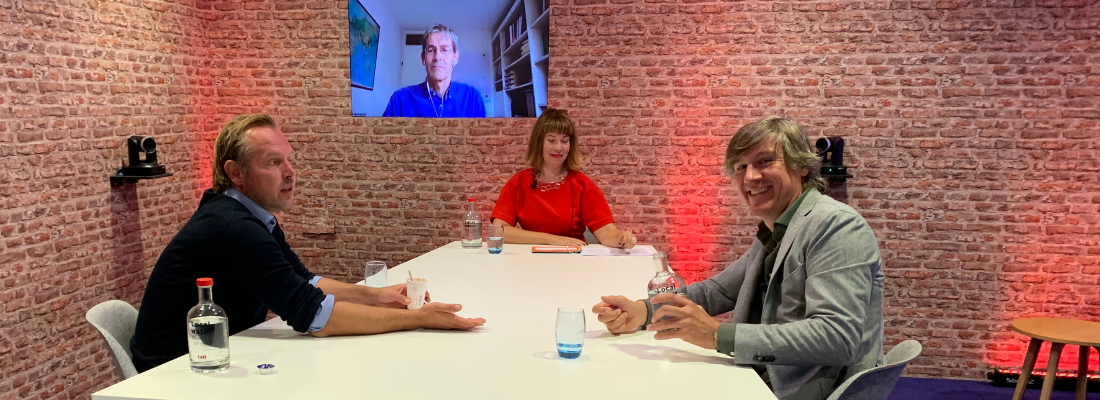ON AIR 5 | European Green Deal: Sustainable urban mobility
The forthcoming European Green Deal will push forward a sustainable mobility agenda that encourages authorities, employers and service providers to offer sustainable mobility alternatives and entice commuters to use them for their daily journeys to their place of work, a practice that is gradually creeping back into our daily lives.
The European Green Deal;will undoubtedly force us to question the way we live and as a result many cities are currently reallocating public space to active mobility, changing parking policies and offering financial incentives to encourage micro-mobility, sustainable collective transport, pedestrianized streets and the creation of temporary bike lanes. Alternatively there are also many examples of cities turning pandemic-induced temporary lanes into permanent measures or widening existing bike lanes. But how do we stay on track in this sustainability transition and what is required to get things started?;
text
During this Intertraffic ON AIR episode four experts, Lucas Harms, managing director of the Dutch Cycling Embassy; Ronald Jorna, Bicycles & ITS project manager for the Dutch province of Overijssel; Pieter Litjens, general director of CROW; and director of new ventures at MaaS Global, Peter Kuhn discussed what must be done to maintain the set course. While at the same time ensuring that mobility access is available for everyone – inclusive and not exclusive. Our panellists talked about their organisations’ contributions to the wider ethos of the Green Deal.
Dutch Cycling Embassy: The people’s republic of bicycles
The Dutch Cycling Embassy is a public private network for sustainable bicycle-inclusive mobility offering knowledge, experience and experts from private companies, NGOs, research institutions, national and local governments. With the Embassy celebrating its 10th anniversary this year, Harms and his organisation are looking to capitalise on the increase in cycling as an everyday activity - one of the few positives to have emerged from the Coronavirus pandemic.
The Embassy, says Harms, has conducted more than 40 Think Bike workshops inspiring cities to use the Dutch cycling model. One such city that has taken the cycling bull by the proverbial horns is Paris. Forward-thinking Mayor Anne Hidalgo has ensured that cycling is at the forefront of her inspirational transformation of Paris's transport network by implementing the 15 Minute City (La Ville de Quart d'Heure) project using Dutch principles. "The Think Bike workshop in Paris in 2019 was very successful and one of its focuses was intersection design. Paris is implementing 600km of bike lanes thanks to Mayor Hidalgo's grand vision," says Harms proudly, "but they need expertise as the design of intersections is often the weak link."
Another city feeling the benefit of Harms' organisation's expertise is Los Angeles, the host city for the 2028 Summer Olympics (with the aforementioned Paris the 2024 hosts). Harms says that key to increasing bicycle use in LA is the pairing of it with access to public transit, something that the Dutch Cycling Embassy are helping the city to achieve."The combination of cycling to the bus or train is key to any successful scheme in a low-density city such as LA," he maintains. "50% of all train journeys begin and end with a bike ride - but cycling is not a goal in and of itself. It's a transformational tool."
Bicycles and ITS: Data is the key
Overijssel’s Ronald Jorna is the man in charge of the Bicycles and Intelligent Transport Systems project. BITS is a multi-stakeholder project that is seeking to reduce CO2 emissions by 9% and increase bicycle use by 10% within target groups.
Under the auspices of the BITS project 10 partners from top cycling countries (Netherlands, Denmark, Belgium, UK and Germany) came together in a consortium to raise awareness of best practices of “Smart Cycling”, and to provide implementers with ready-to-use information and evidence from different regions. This project is believed to be the only one of its kind in the world. The BITS project, co-funded by the North Sea Region (NSR) Programme, has a budget of €5 million over 3 years (2019 to 2022).
“The long-term effects of more and better cycling data is better cycling policy”
Among Jorna’s main objectives for BITS is the better use of cycling data. “The long-term effects of more and better cycling data is better cycling policy,” he maintains. “This leads to greater levels of sustainable transport that is more convenient and safer. And that,” he asserts, “will lead to an increase in cycling.”
The approach of BITS is based on the Bicycle Pyramid that is derived from Maslow’s pyramid. The pyramid structures needs from cyclists and conditions to stimulate cycling. The idea is that the needs on the bottom of the pyramid need to be met before the next level becomes relevant. “This means that cycling can be made more attractive by improving the surroundings but improving the surroundings alone will not have a big impact if cycling is dangerous.”
ITS implementations that address the right level of the pyramid will be used to stimulate cycling and these ITS applications will generate valuable data that is collected in a ‘CycleDataHub’. “Some of this data feeds back directly to cyclists. In addition, these ITS systems will produce data on cyclists and infrastructure utilization, which provides valuable input for cycling policy. Improved policies will then attract more cyclists and generate even more bike data.”
MaaS Global: The bike as a mode of transport
MaaS Global’s Peter Kuhn reinforced his company’s view that cycling is a key component of the Mobility as a Service agenda. “Users dictate services. It’s what the consumer feels that matters,” he explained. “Not what we as a company or as an industry as a whole are most comfortable with. We need mobility options to be available 24/7, 365.”
“Users dictate services. It’s what the consumer feels that matters.”
Asserting that the car-centric approach to life needs to change, Kuhn suggested that incentivisation is the way forward via the subscription-based seamless, convenience of a MaaS service, such as MaaS Global’s Whim. What’s more, Whim data shows that 42% of customers combine the use of a bicycle with a public transport mode.
“There needs to be more focus on socialisation – on playing or just sitting. We need to know that there are other options available, that we don’t need to drive and we don’t need to own a car. Mobility as a Service allows for your way of life to change.”
CROW: In life you must have a (cycle) vision
For CROW’s Pieter Litjens, of equal importance as data and accessibility, is a clear vision of how cycling fits into the whole mobility narrative. CROW’s role as knowledge developers and experts in the application of that knowledge means, says Litjens, that for cyclists, sustainability “equals liveability”.
Litjens talked eloquently about cycling’s important role in the battle against climate change, and also of the creation of roundabouts for the sole and express use by cyclists, but his point about two-wheeled road users’ need to be considered rang loudest.
“What do you want from an authority? You want a clear vision and you want a executable plan that facilitates sustainability, accessibility, mobility and liveability. Cyclists and pedestrians need a clear place or a clear role in the overall mobility infrastructure,” he insists.
One country that he believes is at the forefront of just that practice is Denmark. “Denmark has these cycling bridges – they are built for cyclists with cyclists in mind but more than that it shows that that city or that country cares about cycling. It’s a tangible sign that you, as a cyclists, are being considered and thought about.”
“Denmark’s cycling bridges are a tangible sign that you, as a cyclists, are being considered and thought about”
Watch the full episode of Intertraffic ON AIR >
Related Content:
Share your story
Do you have an innovation, research results or an other interesting topic you would like to share with the professionals in the infrastructure, traffic management, safety, smart mobility and parking industry? The Intertraffic website and social media channels are a great platform to showcase your stories!
Please contact our Sr Brand Marketing Manager Carola Jansen-Young.
Are you an Intertraffic exhibitor?
Make sure you add your latest press releases to your Company Profile in the Exhibitor Portal for free exposure.
Get up to speed on the mobility industry - our newsletter straight to your inbox!








